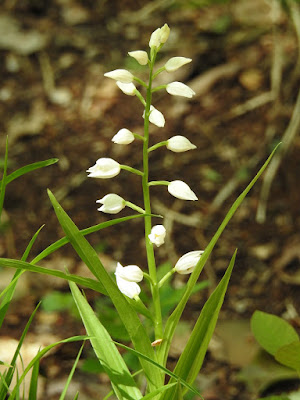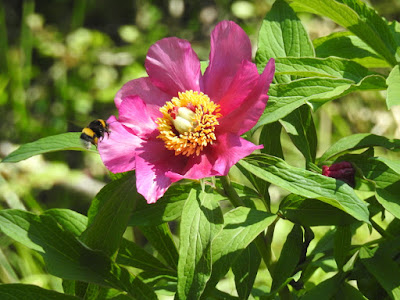After the return from the Danube delta we can now enjoy in our favourite environment: the forest! This time of year is particularly busy for the woodland inhabitants, especially woodpeckers. In this post we'd like to share some exciting moments we've witnessed recently at our local patch on the Slovenian Karst, just a few minutes drive from our home.
Since 2015 we've been working on the occurrence of Middle Spotted Woodpeckers Dendrocopos medius in the Karstic region and right now a paper on the species is about to be published. In the last years, we carried out censuses in suitable karstic woods, where this rare oak-tree specialist might be present (see here & here). So far we have only found probable signs of nesting... until a few days ago, when we finally confirmed the nesting of this species in the Karst with the most obvious sign: an active nest-hole!
The activity in and around the nest is frantic, with the parents going in and out of the hole, delivering beakfulls of caterpillars to their chicks...
The activity in and around the nest is frantic, with the parents going in and out of the hole, delivering beakfulls of caterpillars to their chicks...
In our case, the nest is located on a rotten branch of a beech Fagus sylvatica in a woodland of sessile oaks Quercus petraea. The hole is about 4-5 meters above the ground. In the first photo below two other larger holes are visible - those most probably belonged to Great Spotted Woodpecker.
In the next photos, note the characteristic erected red feathers on the head of the male (first two pics). Males have brighter crown feathers than females and when erected, they tend to be more conspicuous. The head colour can be easily compared when seeing both sexes together, such in the case of a nesting pair. Moreover when males approach the nest, they tend to erect the crown feathers as a sign of display. If you compare the sexes in all the photos, you will see that the female
tends to have a more "gentle" look and not so bright red crown
feathers. Note also the facial expression of the bird looking out from the hole (3rd photo below) - it is quite unlike any other woodpecker as it lacks moustachial stripes and the face looks quite plain.
When observing the nesting pair we payed attention not to disturb them and watched from a safe distance. Nevertheless the pair seemed very concentrated in bringing the greatest possible amount of food to the chicks and didn't bother our presence (short VIDEO). Middle Spotted Woodpeckers find their food mostly by gleaning and search the oak bark for small invertebrates and their larvae. At this time of year the main food brought to the chicks are caterpillars found in the tree canopies, but also other small insects (see pics below). In this respect Middle Spots are a bit like Blue Tits Cyanistes caeruleus or other Parus species that need to coincide their breeding with the greatest prey availability - that is, when the new green leaves are full of caterpillars.
The frentic activity of feeding the chicks should continue for at least a week, so we'll keep checking the status of the brood in the coming days.
Meanwhile the forest around the nest is alive with many other species. A Grey-headed Woodpecker Picus canus is "disturbing" the Middle Spots, drumming a few meters away from their tree and a Black Woodpecker Dryocopus martius should also be nesting somewhere in the same wood, together with a pair of Green Woodpeckers Picus viridis. And two more occupied cavities were found not far away...
Meanwhile the forest around the nest is alive with many other species. A Grey-headed Woodpecker Picus canus is "disturbing" the Middle Spots, drumming a few meters away from their tree and a Black Woodpecker Dryocopus martius should also be nesting somewhere in the same wood, together with a pair of Green Woodpeckers Picus viridis. And two more occupied cavities were found not far away...
A female Lesser Spotted Woodpecker Dendrocopos minor
is looking out of her nesting hole. Note the tiny beak of the species,
not really woodpecker-like. In fact its feeding technique is more
similar to that of tit Parus species rather than that of other
woodpeckers. But despite this, Lesser Spots still need to build the nest
to rise up the chicks and usually every year a new hole is excavated.
Great Spotted Woodpecker Dendrocopos major has a more poweful beak and usually excavates several new nesting holes every year. Here it chose to do so in a rotten beech Fagus sylvatica - such trees have softer wood and in general are preferred by most woodpeckers.
 |
| Rhagium mordax (Cerambycidae) feeding on Paeonia's nectar. |
 |
| Ophrys insectifera - rather rare on the Karst, but we have it "in the backyard"! |
 |
| Cephalanthera longifolia - a common woodland orchid. |
 |
| Orchis purpurea - like woodland edges and sunny open woods. |
At the end a note is necessary: all the above woodpecker's
holes were found exclusively by Sara, whose primary interest this spring
seems to be nest-hole finding! ;-)


















